Curriculum, Reviews, Schedule, & Strategies for Our 6th-Grade Homeschool
Need help deciding what homeschool resources to add to your 6th-grade curriculum? What subjects should you include as your child enters middle school?
Below I have listed our 6th-grade curriculum picks for this year. Some of our resources come from organizations we used before and love and others are new and seem promising. I have also included end-of-the-year reviews for each curriculum to help you decide if it’s the right choice for your family.
If you’d like to see what our 6th-grade homeschool schedule will look like, continue scrolling.
You will also find common expectations for this school year and our tips and strategies to help with transitioning from elementary to middle school mode.
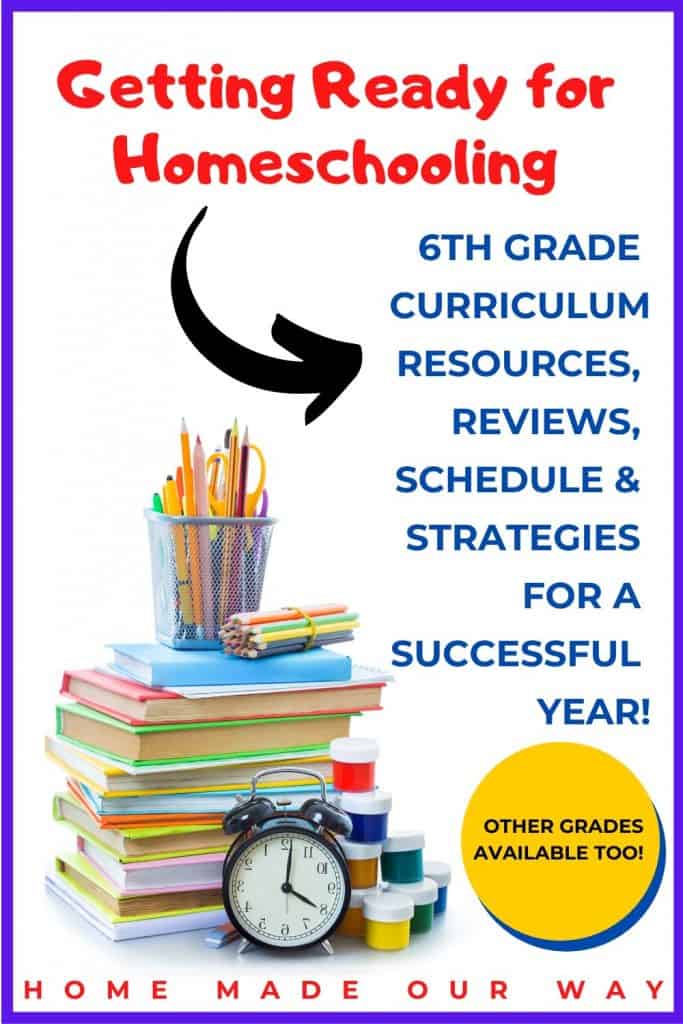
Disclosure: This post contains some affiliate links for your convenience (which means if you make a purchase after clicking a link I will earn a small commission but it won’t cost you a penny more)! Click here to read my full disclosure policy.
Our 6th-Grade Curriculum Resources & Reviews
Math
We have been using Math-U-See for the past three years and it works very well for our family. The boys really enjoy watching the videos and seeing if they can solve a given problem before the answer is given.
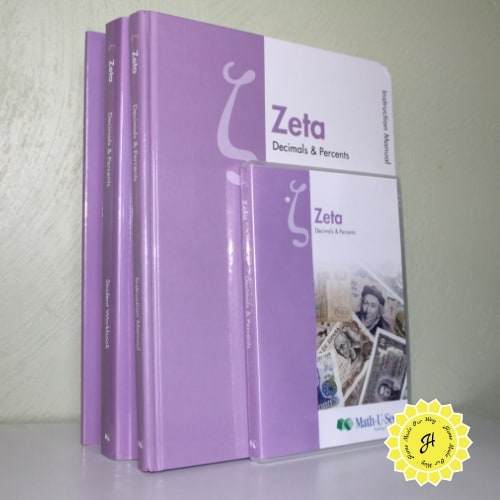
This year they will be taking on Zeta level which focuses on:
- decimals
- percents
- metric conversions
- mean, median, and mode
- probability
- area of a circle
- angles & more.
Updated Review:
This was our 4th year using Math-U-See and I can’t say enough about it. Their approach is to get students to “see” concepts instead of just “telling them a concept” and hoping it sticks.
My kids then go on to master every concept by doing all the practice and review sheets and it shows on their tests.
I know some parents have reservations about this curriculum because it appears overwhelming but I’m here to tell you that that doesn’t have to be the case.
In fact, I wrote a whole post on → how to best use and schedule Math-U-See ← so that your kids can master concepts in their own time without the overwhelm. Check it out by clicking the above link.
Language Arts/Writing
For our Language Arts and Writing assignments, the boys will be using BJU‘s English 6 Curriculum. We used BJU for 3rd and 4th grade, but last year I decided to try a more Charlotte Mason approach to this subject.
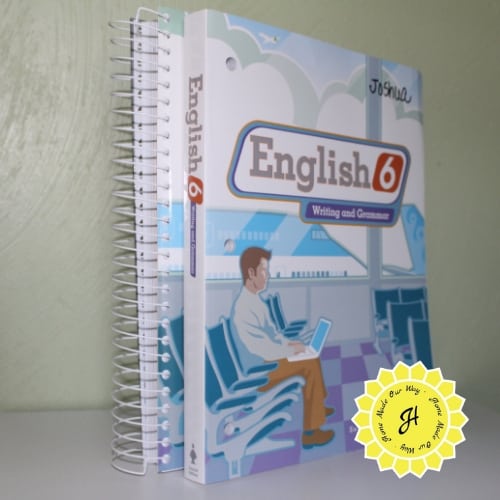
Unfortunately, Joshua was having trouble with dictation so we ended up going back to BJU’s curriculum. We have done well with BJU so I decided to stick with them again.
Updated Review:
We have been using BJU Press for 4 years for our language arts and writing. When it comes to learning language arts and grammar, I think this curriculum is great.
However, after 4 years of their “writing component”, the boys and I are bored to death of it. It was really turning us all off to writing.
With that, I decided to omit the writing chapters and come up with our own writing assignments. So, instead of writing a “friendly letter” for the 4th time, the boys were allowed to write up summaries on people and things they were currently learning.
By letting them choose a historical person, event, or scientific concept to write about, they were more willing to write.
So what does this look like in our homeschool? We took on a writing assignment every other week. This gives them time to decide on their topic or person, do a little research, and order books from the library.
We also use our membership with NotebookingPages to make our reports look good.
Here is how we scheduled our writing assignments:
- Monday: planning (usually an outline of their paper based on their research)
- Tuesday: drafting
- Wednesday: revising and proofreading
- Thursday: bibliography and images added
- Friday: formatting and publishing the final paper

Literature
For literature, I simply assign readings throughout the year and try to include different types of literature.
Here is what our year in literature looks like:
- August/September: Gulliver’s Travels
- September: various poems from A Child’s Garden of Verses by Robert Louis Stevenson
- October/November: Much Ado About Nothing by Shakespeare
- November/December: Percy Jackson and the Lightning Thief
- January/February: various short stories
- The Little Match Girl by Hans Christian Andersen
- An Occurrence at Owl Creek Bridge by Ambrose Bierce
- A Dark Brown Dog by Stephen Crane
- The Cask of Amontillado by Edgar Allen Poe
- The Gift of the Magi by O. Henry
- March: The Man in the Iron Mask
- April/May: As You Like It by Shakespeare
Shakespeare is not easy but I pair the readings with movie clips. So after we’ve read a scene, I’ll queue the movie up to that scene and we are able to understand it a bit more.
Updated Review:
When it comes to Shakespeare, Jack and Josh are polar opposites. Josh loved getting into character when reading his parts. Jack, not so much. He is not impressed by the readings but doesn’t mind watching the movies.
If you decide to take Shakespeare on, I suggest getting a kids’ version. I’ve provided links to these in the above list.
History
Our history component has several parts that include world history, world geography, U.S. geography, and U.S. government.
World History/World Geography
This year we will stick to our newly-loved curriculum, Story of the World by Susan Wise Bauer. We started this last year covering the first 2 volumes. So this year, we are going to take on Volume 3, Early Modern Times.
We will also use Homeschoolinthewoods.com’s Record of Time for placing figures and events that we learn throughout the year. Click here for a full review of these history curriculums.

We also love watching the History Channel’s DVDs: Mankind, The Story of All of Us, and America, The Story of Us.
As I wrote earlier in regard to their writing assignments, the boys are expected to do a one-page research paper on a historical person or event of their choice.

Updated Review:
I love The Story of the World because it doesn’t just cover the typical European/American history I encountered throughout my elementary years. This curriculum covers the Far East, Africa, and even Australia.
If you decide to add the above DVDs, I suggest you view them by yourself beforehand. Because it covers major wars and battles here and there, you will find that some of the scenes are a bit graphic and violent.
If you find some scenes too gruesome, then try to queue the DVD to other parts of the movies that are relevant to the time in history you are covering. It’s a shame to not let the kids watch history unfold before them. The History Channel really outdid itself.
U.S. Geography
Just as last year, we will use Notebooking Pages United States state study forms to research various state facts such as the state motto or state symbols.
We also pair this with Highlight’s Which Way, USA subscription. We only have 16 states left this year so we will finish this curriculum in March.
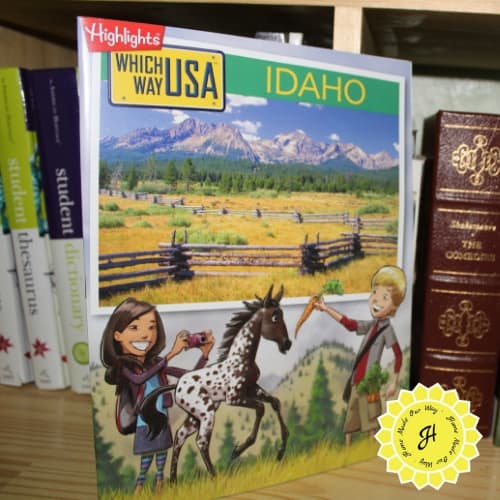
Updated Review:
While I do not care for the mazes and crossword puzzle activities in Highlight’s Which Way, USA subscription booklets, they do have other fun activities that require fact-checking and mapping skills.
U.S. Government
Because this is a presidential election year, I decided to postpone our U.S. geography curriculum in October to cover this subject. I have purchased and read through Presidential Elections and Other Cool Facts by Syl Sobel and I think it is a great resource for this topic.
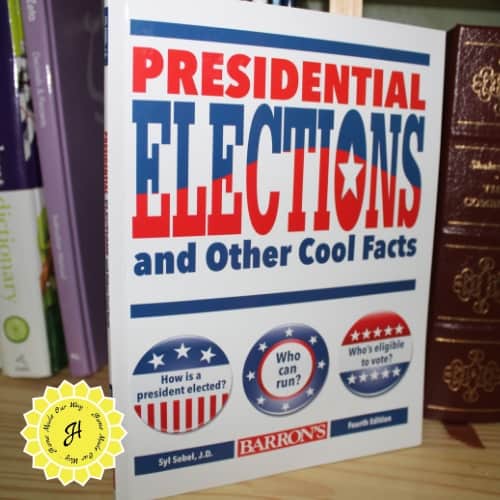
Updated Review:
Presidential Elections and Other Cool Facts by Syl Sobel was perfect. It covered the electoral college, campaigns, and of course, our election process. Sobel even sprinkles some historic facts here and there.
We also got to watch a couple of debates. On election day, I printed out a blank U.S. map where the kids could color each state blue or red depending on the candidate who won that state.
We also tallied the electoral college votes on our whiteboard until we reached the winning number. I still can’t believe how excited the boys got on election day. They really took to their activities.
Science
This year I am taking a different approach to our science curriculum. This summer I came upon Building Foundations of Scientific Understanding by Bernard J. Nebel, Ph.D. After reading the introduction to this book, I decided to give it a shot.
In fact, I went ahead and purchased the next book as well, Elementary Science Education. Although the first book is geared towards K-2 grades the author suggests starting from the beginning because it’s possible there have been things that were missed in other curriculums.
Nebel recommends using his books (there are 3) together as he has created a way to integrate science topics for better understanding. He provides a flowchart for how to teach each topic as well as the pre-requisite topics students need before moving on to the next topic.
Again, as I wrote previously, I am including a writing component with this subject. The boys can research either a science topic or a scientist of their choice.
We will also be learning about the periodic table elements. We will cover one element each week and write down facts on our element report page from NotebookingPages (this site has everything, can you tell?).
The books we will use for the elements are:
- Elements: A Visual Exploration of Every Known Atom in the Universe by Theodore Gray paired with his element cards
- The Periodic Table: Elements with Style! By Basher
- The Intriguing Story of the Elements by Jack Challoner
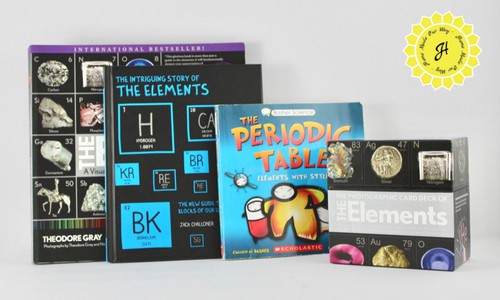
Updated Review:
First, let me warn you that Dr. Nebel’s books are not textbooks or workbooks for kids. These books are guides for parents to use in order to teach different science concepts. So if you are looking for a put-together for your curriculum, this is not it.
You will have to read each component, follow along with his suggestions, and create any other activities you want such as worksheets, vocabulary lists, or graphs for projects and lab experiments.
Despite the fact that putting the curriculum together takes a bit of time, I really do love this resource. Dr. Nebel explains each concept in simple terms and best of all, his experiment suggestions are doable.
That is, most of the materials can be found in the home. The few items I have had to buy were things that I found easily at Walmart or on Amazon. You don’t have to worry about trying to find crazy electronic parts or chemicals.
Also, Theodore Gray’s Elements book and cards are a must for any school. The book’s layout and photos are beautiful and he provides all kinds of facts about each element. By the way, most of the photos provided come from his own collection.
Electives:
Computers
Although the boys are really good at getting around on a computer, I wanted to find a curriculum that introduced them to other computer applications they are going to need in the future. I scoured the internet over the summer trying to find an appropriate curriculum and found Homeschool Programming Inc.
They offer various courses including programming for young gamers. They also provide a curriculum syllabus for each course helping to plan out my whole year. The course we will be taking is called Digital Savvy for learning simple computer skills.
Another technology course I am adding as an elective is called EEME. This is a monthly subscription service that sends out kits with various electrical components that kids get to put together and create different functions. I came upon this after being disappointed with Lego’s pricey kits.
Updated Review:
The boys can’t wait to learn game programming but I delayed this so they can learn some basic computer skills first. And I am so glad I decided to do it this way.
What they are learning now, they are applying to their research reports such as word processing, using images, and search engines. This program even teaches about spreadsheets, social media, and how to be safe online.
Typing/Keyboarding
This is also a new subject for the boys. Seeing that they will be taking the above computer course I figured they should start learning to type as well. I chose the Mavis Beacon Teaches Typing Family Edition download from Amazon.
As far as scheduling goes, I am only going to require typing practice on those days that they are not working on research papers since this gives them an opportunity to practice their typing skills already.
Updated Review:
I think the Mavis Beacon software did a good job of teaching the boys how to type. Josh has really taken to using his skills whenever he is on a keyboard; Jack, not so much.
Spanish
I am currently working on creating this curriculum as opposed to buying one. For the past three years, the boys’ Spanish consisted mainly of naming and labeling objects.
I believe they are ready for small phrases and sentences. I’ll keep you posted if I am able to create this curriculum or give in and buy a curriculum.
Updated Review:
So far I have been winging this without a curriculum. I have not found anything that goes beyond simple labeling and maybe a few common phrases.
I did start touching upon the basics of verb conjugations in order to get the boys to create simple sentences but I am running into a little trouble finding resources to further their grasp of the language. Would love to hear from anyone who has a great resource.
Health
This year I decided to add this book as the boys are embarking on puberty very soon. I chose Kelli Dunham’s The Boy’s Body Book because it has a strong focus on puberty, hygiene, and safety. I plan on adding this in when our U.S. Geography component is finished in March.
Updated Review:
We finally got to read the Boy’s Body Book in March and have to say that I liked it. The boys not so much.
It is really meant to be read by the boys only (to make it less embarrassing) but I thought we would read it together in case they had questions. I remember being so confused about all things ‘sex’ at their age and I didn’t want them to feel that they couldn’t rely on me for the truth.
Well, if you’re a mom, let Dad or another male relative handle the first chapter. Unfortunately, my husband was deployed when we started this curriculum.
It is not that the chapter talks about intercourse, it doesn’t. I think explaining that is actually easier than explaining ‘nocturnal emissions.”
Of course, the boys looked at me with big eyes and open mouths trying to understand something that I had no experience with.
There were giggling red faces, and a whole lot of questions to which I replied, “Ask your dad more about it when he comes home”. Mama mia!
However, the other chapters were way more boring than the first one but I appreciated the topics that they covered such as caring for one’s body, peer pressure, cyberbullying, and even drugs and alcohol.
We had lengthy discussions about each topic so that I can see whether they understood what we had just read and how important these things were as they go through puberty.
I definitely recommend this book if your son is about to hit puberty or has questions about his body. And you don’t have to worry about it being too graphic (there is one drawing of a penis but it is in good taste, labeling parts).
I wasn’t sure if the book would go into intercourse but you can rest easy if you feel your sons are not there yet. They do not touch upon that at all.
Finances
Update: This particular subject was not covered this year but rather in our 7th-grade class. However, I thought I’d add it here because I believe it is appropriate for grade levels 4 to 7.
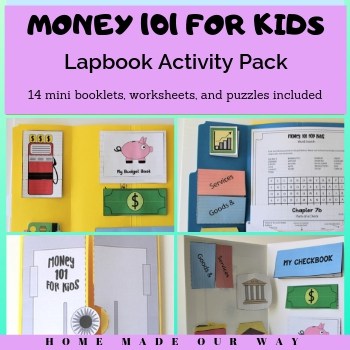
I actually created this lapbook curriculum using Walter Andal’s Finances for Kids as a guide. If you would like to learn more about our Money 101 for Kids lapbook activity pack, ← click here.
I hope you find the above curriculum and reviews helpful when putting your lesson plans together. If you have any questions about the curricula please feel free to reach out to me at [email protected] and I’ll gladly help in any way I can.
Our 6th-Grade Homeschool Schedule
Now that you’ve had a look at the different topics and subjects we are going to cover this year, here is what our schedule is going to look like.
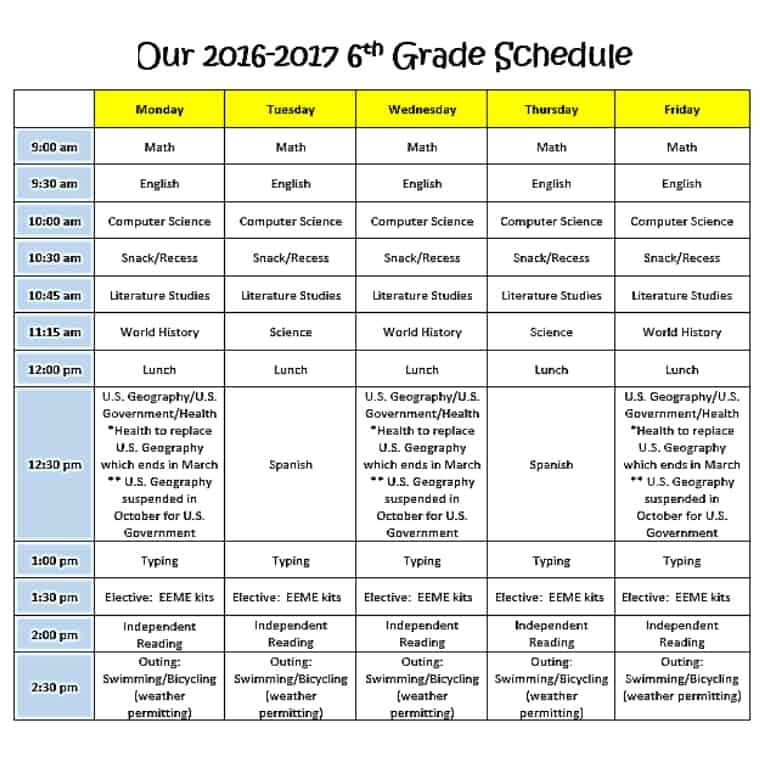
As you can see I give each subject a 30-minute slot. This is not set in stone since some subjects may need more time while others can be completed in less time. In the end, it tends to work itself out.
Also, I neglected to mention “writing” on the schedule but this is done during their English slot every other week.
And let me clear up any confusion with the 12:30 pm slot. We will start the year with U.S. geography, then suspend that in October to go over our presidential elections curriculum. Then, we resume U.S. geography which we expect to finish in March.
After, we will fill this slot with our health class which should take us to the end of our school term.
6th Grade Strategies for a Successful Year
Expectations
So what kind of changes takes place when your child transitions from grade school to middle school? If you need answers to these questions, you are not alone.
As kids enter middle school, they have already started or will soon start going through puberty. I mention this because as their body begins going through changes, you will notice that they will become crankier, will eat more, and will need more sleep. To help combat this, I suggest letting kids sleep in a little longer.
I plan on letting my boys sleep in a bit with an extra hour of sleep. This will probably change every year little by little and by the time they are in high school, they will probably need much more sleep. I’m not worried since I hope that by that time they will be fully independent when it comes to their schooling.
Independence
You can also expect that your child will think they know everything, in fact, they will think they are smarter than you. This is normal. They are learning to think for themselves. It is just their way of asserting their independence.
They want to do things without your help or advice. And yes, they will try to test your boundaries just as they did as toddlers. In some cases, they may even throw a ‘teen’ tantrum.
This need for independence is also hard on parents. We want to keep them safe and have them develop good habits, and yes, some of us just find it hard to let them grow up.
So, to help with their need for independence and our need to keep them reined in, I suggest coming up with a list of expectations, rules, and consequences if they do not comply. Relay these to your child and let them decide how they will handle their behavior so that they can be successful.
For help with creating your list of expectations, rules, and consequences, click here to check out this example from a middle school teacher.
Our Expectations
Here are a few expectations I listed for my kids both for home and school. They are:
- expected to read more independently (cut down on ‘read-alouds’ with mom)
- allowed to complete work where they feel comfortable (except during instruction time)
- to set their own alarm at night and are responsible for getting to homeschool at a reasonable time
- allowed to take recess/lunch when they want to (except during instruction time)
- are responsible for keeping their work and workspace orderly
- responsible for studying and reviewing work before tests and quizzes.
As each year passes, I will give them more responsibilities and more opportunities to make better decisions.
As for consequences, these are dependent upon your situation. For example, my boys love their time (away from homeschool) so if they do not follow rules or fall short of the above expectations, their “time away from homeschool” is shortened. And they do not like that.
So just make clear any consequences you come up with and follow through with them. Else they will never take seriously the rules or expectations you’ve set up.
Final Thoughts on 6th-Grade Homeschooling
Remember that 6th grade is an important milestone in your child’s life regardless of whether they are homeschooled. It is a time of change both physically and mentally for them.
Understand that they are going through some serious changes and it is a very confusing time for them. Take time to talk to your children about these changes to get a sense of what they need.
Also, schedule their homeschooling but allow them some wiggle room to get things done. And don’t forget to come up with a list of rules/expectations. Then have a “meeting” and go over these expectations as well as any consequences.
Happy Homeschooling!
More Helpful Posts for Your Homeschool
Need curriculum resources for other grades? Click any of the posts below:
- 5th-grade homeschool curriculum resources
- 7th-grade homeschool curriculum resources
- 8th-grade homeschool curriculum resources
- 9th-grade homeschool curriculum resources
Save This
Want to save this for later? Want to share it with other homeschoolers? Hover over the pic below and click the Pin It button to pin it to your favorite homeschooling Pinterest board.
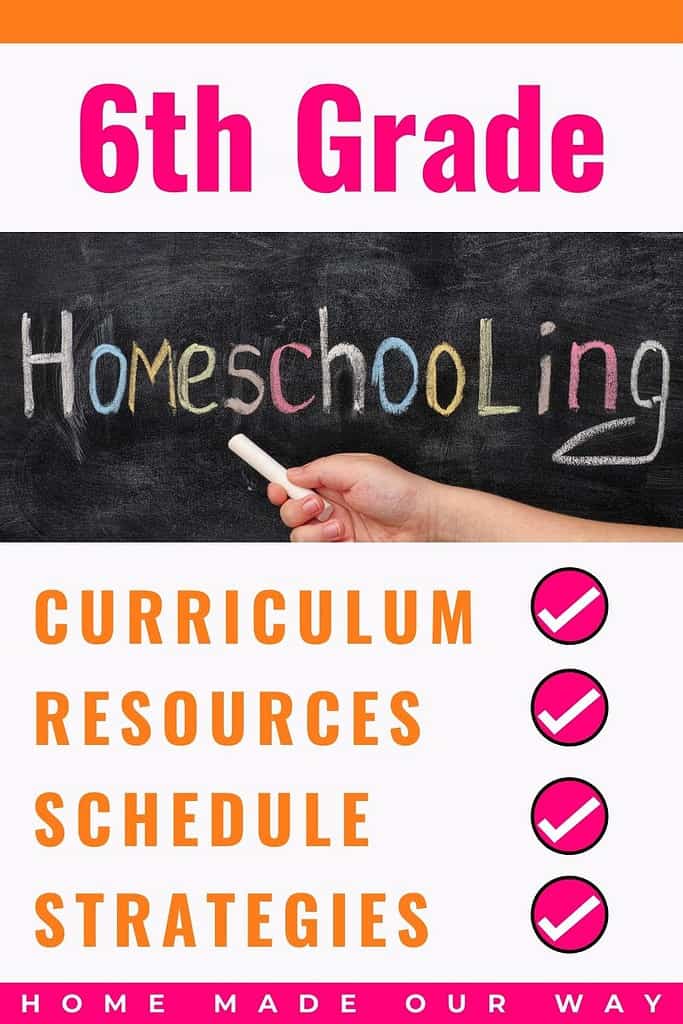
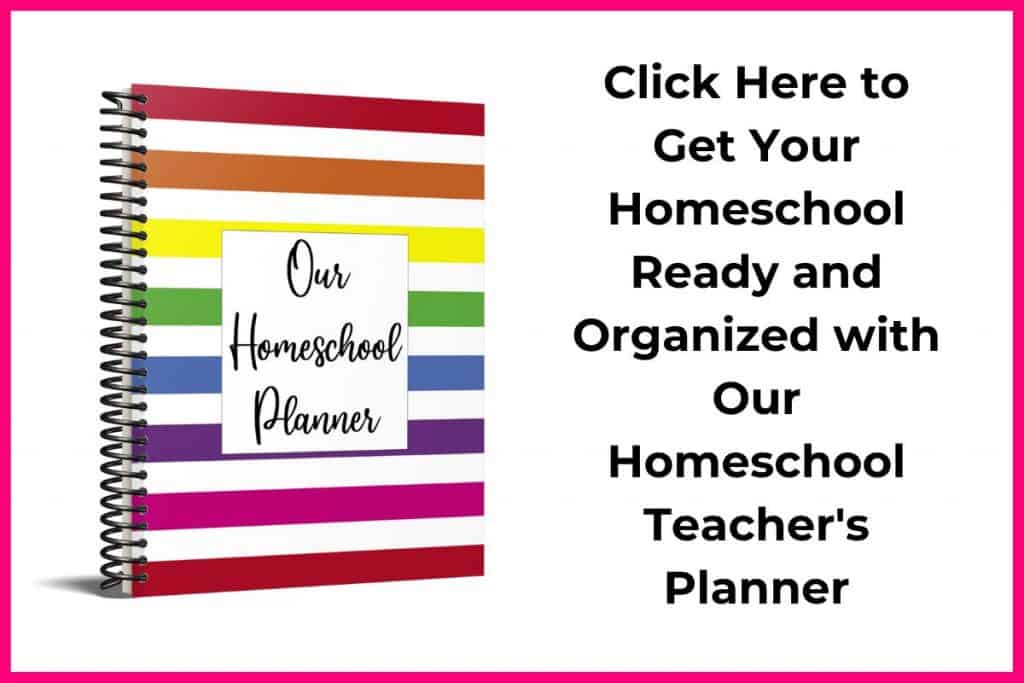
Leave a Reply